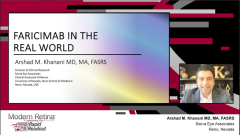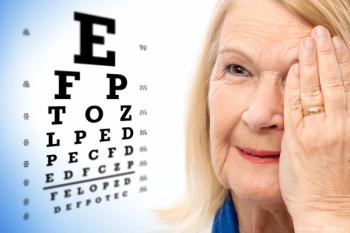
Learnings from Real World Evidence of Faricimab in nAMD and DME: Part 2
Arshad M. Khanani, MD, MA, FASRS, highlights the fluid resolution with faricimab and the need for loading doses, especially in high-needs switch patients with nAMD or DME.
Episodes in this series
Arshad M. Khanani, MD, MA, FASRS: What is learning No. 3? We’re using a Notal OCT [optical coherence tomography] analyzer for fluid quantification in [the] TRUCKEE study to really quantify the fluid and it’s showing that faricimab offers advantages in improving fluid status of patients with neovascular AMD [age-related macular degeneration; nAMD]. We also know that [the] majority [of] but not all faricimab-treated patients will improve after 1 injection and loading may be necessary. I’ll share some data on that with you. And then in high-need switch patients, loading may continue to improve anatomy.
So, let’s look at some of the data from [the] TRUCKEE substudy. This is fluid quantification after 1 faricimab injection. We have 262 eyes, and you can see there is an improvement of almost 120 nL of fluid after 1 injection and 72% of eyes showed improvement in fluid after 1 injection. And when you look at naïve as well as aflibercept-treated patients, you can see that anywhere from 60% to 70% of patients had improvement after 1 injection and keeping in mind the interval before and after is comparable when we’re looking at the switch patients from aflibercept. Here [are] the data which [show] change in fluid volume with successive faricimab treatment so you can see that the fluid status continues to improve as we continue to treat. One thing to notice that after the 3 loading doses you can see the interval of treatment is increasing while the fluid continues to decrease, really highlighting that we can control disease very well with faricimab as well as we’re able to extend treatment intervals.
So based on this learning, I’m loading most of my patients that I’m switching that had fluid at baseline so that we can have better control and ability to extend treatment interval because Ang-2 inhibition on top of VEGF-A inhibition may take some time to work in some patients. This is an example of a patient from the Notal substudy from TRUCKEE, the fluid quantification, and here you see near full resolution of a high-need patient with subretinal fluid. Patient was treated with 8 [injections of] ranibizumab and 15 [injections of] aflibercept, and you can see there’s a significant amount of fluid that resolves after a single injection of faricimab. This is a patient, it’s interesting, [who] had significant improvement but not complete resolution after 1 injection. This patient was receiving aflibercept in the past; we increased the aflibercept to 2× to 4 mg, still had persistent fluid highlighted in green, and after 1 injection of faricimab you’re able to see significant improvement. This may highlight that just increasing the dose of VEGF-A may not help the patients [who] are high-need; we may need another mechanism of action, which we have in faricimab in terms of Ang-2 inhibition.
Learning No. 6, faricimab may potentially lead to faster resolution of subretinal hemorrhage and subretinal hyperreflective material while minimizing fibrosis. Of course, we don’t have any data in a prospective fashion about this; we have seen a signal in the TRUCKEE study, we presented some data at ARVO [Association for Research in Vision and Ophthalmology] this year about it but more work needs to be done to confirm this observation. This is one of my patients, [a] naïve 1-eye patient with 20/200 vision with subretinal hemorrhage as well as subretinal hyperreflective material. Patient was treated with faricimab to start and 8 weeks after faricimab No. 8 you can see visual acuity is 20/30, CST is normalized as well as no fibrosis seen. This is one of the patients [who] gave us the signal and we’re continuing to look at central subretinal hemorrhage patients. Again, these patients were excluded in the TENAYA and LUCERNE [studies]. So, we really don’t have any prospective data in patients with subretinal hemorrhage.
Learning No. 7, a subset of naïve nAMD patients can be extended longer than 16 weeks with faricimab. This is one of my naïve patients [whom] we were able to extend to 34 weeks. You can see at baseline, there’s subretinal fluid, subretinal hyperreflective material with visual acuity of 20/30. On the right, you can see OCT 34 weeks after faricimab, and you can see that patient has 20/20 visual acuity. This patient was loaded and then did not want to treat an extended or rather PRN and you can see we’re able to extend this patient to 34 weeks. There’s a little bit of activity now at 34 weeks and [the] patient will be treated.
Learning No. 8, it is crucial to ensure that faricimab is drawn accurately and administered without any air bubbles. We have noticed that it’s more viscous than other agents we have seen. So, we must be careful in terms of drawing it properly without air bubbles because we may end up underdosing the patient if there are too many air bubbles and we may not see this efficacy that we have seen in clinical trials as well as in our real-world study.
Learning No. 9, faricimab demonstrates favorable safety profile with rates of inflammation and endophthalmitis comparable to other commonly employed approved treatments. What is the evidence? This is the evidence from [the] TRUCKEE study with 2622 eyes of 2212 patients treated with faricimab, and you can see we have low rate of intraocular inflammation and endophthalmitis. Most of these cases were mild. They resolved with topical plus/minus PO steroids. In most cases, these patients were rechallenged with faricimab because the disease was not controlled with other anti-v, and we have not seen recurrence of intraocular inflammation. Also, the endophthalmitis rate appears to be also consistent with clinical practice. We have not seen any cases of retinal vasculitis or retinal artery occlusion, really showing that the safety of faricimab is comparable to other anti-VEGF agents that are commonly utilized in our clinical practice. And this is from the TAHOE study. Numbers are small here, but we have not seen any cases of inflammation or endophthalmitis or vasculitis or retinal artery occlusion. And last learning, it is super important for our field to generate real-world data on efficacy and safety for any new drug that gets approved for treatment of retinal diseases so that we can learn together how these agents fit into our practice and how we can help our patients with new treatment options that become available. Thank you very much for your attention.
Transcript is AI-generated and edited for clarity and readability.
Newsletter
Get the essential updates shaping the future of pharma manufacturing and compliance—subscribe today to Pharmaceutical Technology and never miss a breakthrough.













































